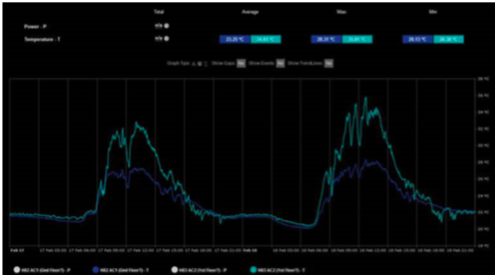Inflector Solar Shades
Radiant Heat Barrier
Inflector Solar Shades
Developed from NASA technology
WHAT ARE INFLECTOR SOLAR SHADES?
Inflector Solar Shades are a unique, energy saving product that acts as a solar filtering, reflective thermal shade. They stabilise the indoor temperature by reflecting or absorbing solar heat and blocking up to 92% UV while allowing natural light and providing a safer, more comfortable environment. They also significantly reduce your energy bills.
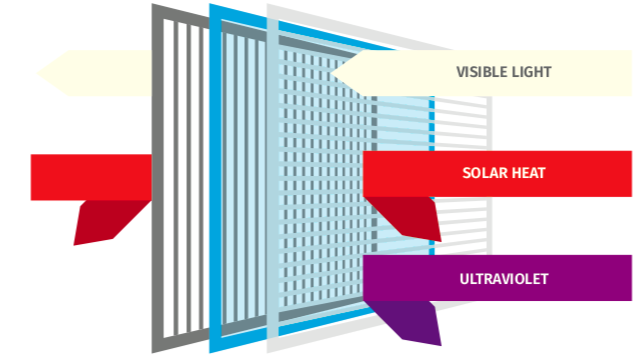
Inflector works all year by keeping heat in the building during winter and keeping it out during the summer. Thereby permanently reducing your energy bills.
Inflector works to save you energy in three ways:
Reflectivity - Reflecting solar heat gain back out.
Emissivity – At most, Inflector only emits 5% of the radiant heat.
Absorption - Inflector’s dark reverse side absorbs heat from the sun in winter and re-radiates it into your building, resulting in lower heating costs
Inflector Solar Shades are uniquely engineered to provide solar filtering and offer a range of installation options to suit each individual building’s interior design. The reflective thermal shades aid in stabilising indoor temperatures by allowing natural light in reflecting
solar heat and UV to create a safer, more comfortable environment along with lower energy bills.
Inflector Solar Shades are the result of many years of research and development, refined into the product we offer you today.
WINDOWS TRANSFER HEAT
Windows are the weakest part of the building envelope and account for heat gain, within a building, in the summer and heat loss in the winter. Heat gain increases cooling costs and heat loss increases heating costs.
A single pane clear window is 20 times less energy efficient than the wall area they replace; and double pane Low-E windows are 10 times less energy efficient than the wall area they replace. This means that on average a building can lose more than 30% of its heat or cooled air out through its windows.
While the amount of heat loss or heat gain through windows depends on whether the windows are single pane glass, clear double pane, Low-Emission coated, or gas filled, the fact is if you have windows you have heat gain and or heat loss every day of every year.
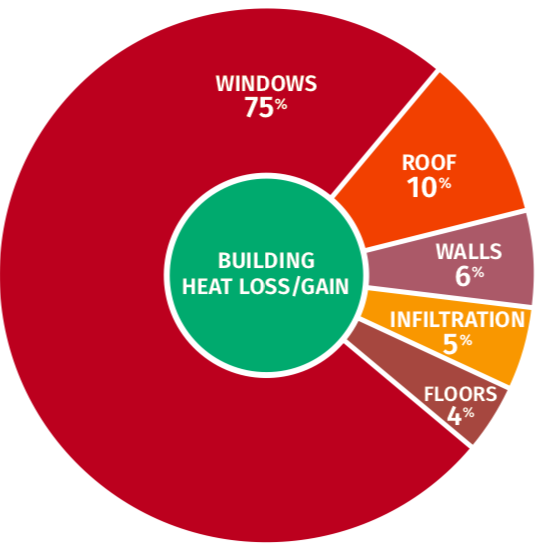
Commercial buildings HVAC loads account for about 63% of all Australia’s carbon emissions.
Innovative Window Insulation Technology
A passive solution which addresses more than just the reflectance of solar heat gain.
HOW DO WINDOWS TRANSFER HEAT?
Windows lose and gain heat through a combination of four factors:
Conduction - The direct transfer of heat through the materials of the window.
Radiation - Infrared energy transmitted through the glass.
Convection - Air gives up its heat to the cooler glass and sinks towards the floor. This sets up air currents that draws warmer air to the glass that is in turn cooled causing a draft.
Air Leakage - The passage of heated air through cracks and gaps in the window fitting.
Inflector Solar Shades address all of the problems caused by windows in building heat loss and gain. Inflector controls reflectivity, emissivity, absorption, radiant heat gain, solar heat gain, privacy, infiltration, condensation and heat loss in the winter Inflector acts as a passive solar collector, absorbing sunlight and radiating free heat into the building.
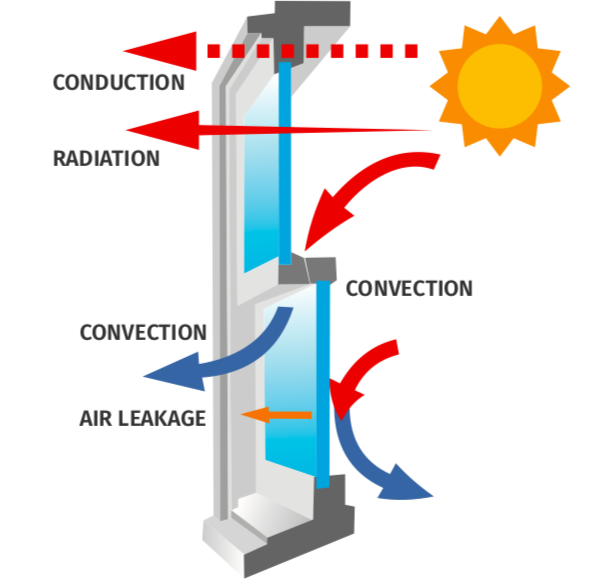
Windows are the weak point in your building’s insulation.
They are where you lose heat in winter and gain heat in summer.
INFLECTOR PREVENTS:
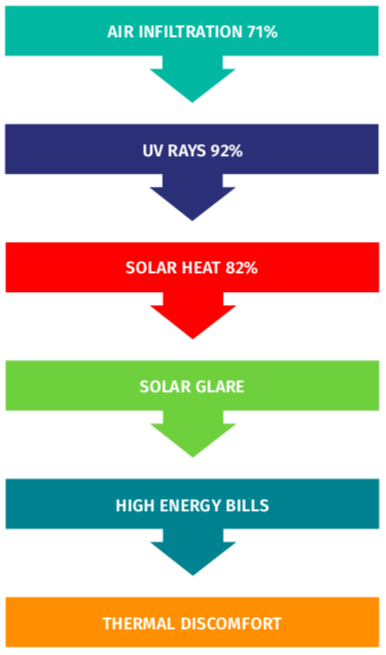
Seasonal Effects on Buildings
Heating and cooling systems can account for over 50% of the overall energy consumption in office buildings.
Summer
In summer windows provide desirable daylight and a view, but also allow in ltration, unwanted glare, heat gain and damaging UV rays to enter buildings. This results in:
- increased greenhouse effect
- increasing interior temperatures
- high cooling/air conditioning costs
- decreasing comfort and reduced worker productivity y UV damage to furniture, carpets, etc.
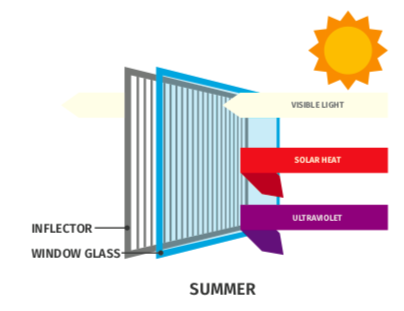
Winter
While windows allow daylight and solar gain which we want in the winter they also allow the sun’s damaging UV rays to enter through the windows. Additionally, heat escapes through the windows when it is colder outside than inside. There is also heat loss due to ex ltration (air leakage).

Commercial buildings HVAC loads account for about 63% of all Australia’s carbon emissions Australia Government - Department of Energy, Resources & Tourism 2013
Inflector Solar Shades during Summer months
Inflector Solar Shades offer an immediate reduction in energy costs and a return on investment of 1.5-2.5 years.
Inflector Solar Shades address all deficiencies of the building envelope pertaining to windows. The shades effectively give beneficial control over reflectivity, emissivity, absorption, radiant heat gain, solar heat gain, privacy, in ltration, and condensation; as well as being a passive solar collector, absorbing sunlight and radiating free heat into the building.
Summer Benefits & Value
In the summer the Inflector Solar Shades are positioned so that the silver side faces out which:
- reflects 72% of radiant heat back out through the window (reducing the greenhouse effect in buildings)
- reflects 65% of solar gain back out through the window (reducing overheating in buildings)
- reflects 92% of damaging UV rays back out through the windows (reducing fading & sun damage)
- reduces cooling requirements saving energy, CO2 and money
- controls glare (especially for computers & televisions)
- provides daytime privacy (one way vision)
- provides cool day lighting with a view
- reduces the load, wear, & maintenance on HVAC units
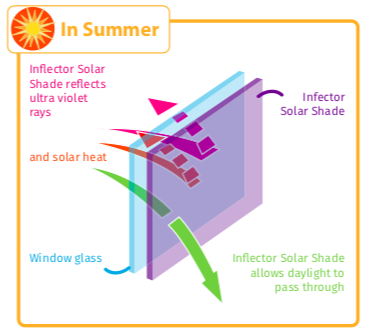
Solar heat reflected from a building due to installing Inflector

Inflector Solar Shades during Winter months
Inflector Solar Shades act as a solar collector in Winter, radiating heat into the buildings thereby reducing heating costs..
Winter Benefits & Value
In the winter the Inflector Solar Shades are reversed so that the silver side (aluminium) is facing inward to reflect the thermal heat back into the building and reduce heat loss through the windows.
Windows with direct exposure to the sun become passive solar collectors with the black side of the Inflector absorbing the sun’s rays and radiating the heat inward. For example a 1.5m2 window with an inflector panel in direct sunlight can produce 2,096 BTU’s of heat per hour, which is equivalent to a 600 watt electric heater.
- damaging UV rays are reflected back outside
- the load, wear, & maintenance on HVAC units is reduced
- reduces heating requirements saving energy, CO2 and money

Live Trial Dunning Avenue Rosebery, Sydney NSW Australia
The attached graph is a representation of a live office trial in Sydney where two identical offices faced due north with the exact same square meterage of glass exposed to direct sunlight. The trial was on the 17th & 18th of February 2016.The temperature differential shows a 33% reduction in solar heat gain at the hottest part of each of the days.
